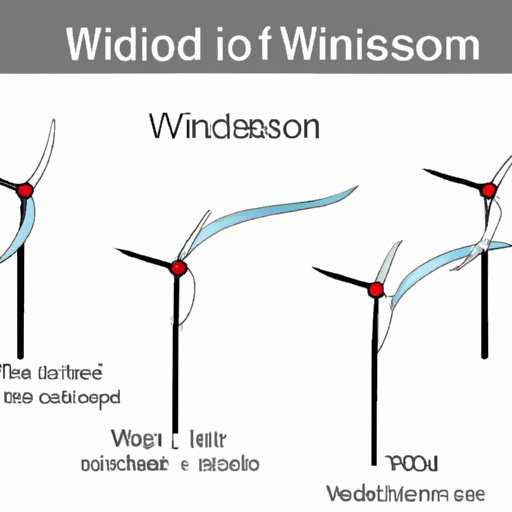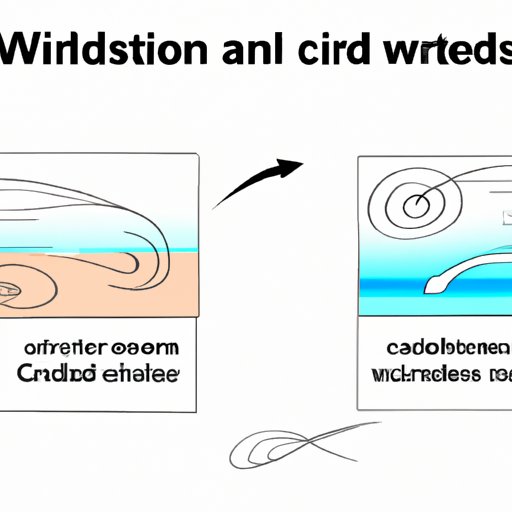
I. Introduction to Wind Direction: Understanding the Basics
Wind is defined as the movement of air molecules from an area of high pressure to an area of low pressure. Wind direction is the direction from which the wind is blowing, and it is an important factor in understanding weather patterns and climate. The study of wind direction can help predict weather patterns and provide vital information for aviation, marine transportation, and other industries. Wind direction can be influenced by many factors, including atmospheric pressure, temperature differences, and local topography.
A. Definition of Wind Direction
Wind direction refers to the direction from which the wind is blowing. Wind is named after the direction from which it originates. For example, a north wind blows from the north to the south. Wind direction is typically measured in degrees, with 360 degrees representing a full circle. It is also often described using cardinal directions, such as north, south, east, and west.
B. Importance of Understanding Wind Direction
Understanding wind direction is important for predicting weather patterns and can help determine the severity of potential storms. Wind direction also plays a crucial role in aviation and marine transportation, where it can affect travel times and the safety of operations. In agriculture, wind direction can affect crop growth and yield, while in architecture, it can impact building design and stability.
C. Global Wind Patterns
Global wind patterns are driven by the unequal heating of the Earth’s surface by the sun. The equator receives more solar energy than the poles, which creates differences in temperature and pressure that drive global wind patterns. The Earth’s rotation also causes a phenomenon known as the Coriolis effect, which influences global wind patterns. There are three main global wind patterns: the trade winds, the prevailing westerlies, and the polar easterlies.
II. The Impact of Atmospheric Pressure on Determining Wind Direction
A. Explanation of High and Low Pressure Systems
Atmospheric pressure is the weight of the air pressing down on the Earth’s surface. High-pressure systems occur when cool dense air sinks and creates a high-pressure zone. Low-pressure systems occur when warm, less-dense air rises and creates a low-pressure zone. These pressure systems can influence wind direction by influencing the movement of air molecules.
B. Correlation between Pressure Systems and Wind Direction
Wind moves from areas of high pressure to areas of low pressure due to differences in air pressure. Air molecules move from high-pressure zones towards low-pressure zones, causing a circulation of air that creates wind. The direction of the wind is determined by the interactions between pressure systems, the rotation of the Earth, and other factors, such as temperature and local topography.
C. Examples of Pressure Systems: Jet Streams, Monsoons, etc.
There are several examples of pressure systems that influence wind direction. Jet streams, for example, are high-altitude winds that can impact weather patterns and aviation routes. Monsoons are seasonal changes in wind direction that occur in certain parts of the world and can bring heavy rainfall. Hurricanes and cyclones are also influenced by pressure systems and can create destructive wind patterns.
III. Factors that Affect Wind Direction
A. Coriolis Effect
The Coriolis effect is the tendency of moving objects to deflect to the right in the Northern Hemisphere and to the left in the Southern Hemisphere due to the Earth’s rotation. This effect is what creates the counterclockwise rotation of low-pressure systems and the clockwise rotation of high-pressure systems in the Northern Hemisphere. The Coriolis effect is a major factor in determining wind direction and strongly influences global wind patterns.
B. Temperature Differences
Differences in temperature between regions can create differences in air pressure that can influence wind direction. For example, during the winter months in the Northern Hemisphere, the polar regions are much colder than the equator, which can create a pressure gradient that drives the circulation of air and the flow of wind. Temperature differences between land and sea can also contribute to wind direction, as sea breezes and land breezes can form due to the heating and cooling of different surfaces.
C. Elevation
Elevation can also influence wind direction. Air molecules tend to rise up and flow over mountains, which can create local winds that blow up and over the mountain range. These winds can create complex wind patterns that vary depending on the time of day and the season. In addition, elevation can impact temperature differences, which can affect air pressure and wind direction.
D. Vegetation
Vegetation can also impact wind direction by creating friction that slows the movement of air molecules. Dense forests and vegetation can create areas of low wind speed that can influence wind direction and create local wind patterns. Agricultural fields and crops can also impact wind direction by influencing temperature differences and affecting air pressure.
E. Water
The presence of water can also influence wind direction. Coastal regions often experience sea breezes during the day, which blow from the sea towards the land due to temperature differences. Inland regions often experience land breezes at night, which blow from the land towards the sea. The presence of large bodies of water, such as oceans and lakes, can also create significant temperature differences that can influence wind direction.
IV. How Wind Direction Influences Weather Patterns and Climates
A. Relationship between Wind and Precipitation
Wind direction plays a major role in precipitation patterns. As air moves over different surfaces, it can pick up moisture and create clouds, which can lead to precipitation. The direction of the wind can determine where precipitation occurs and can influence the severity of storms and other weather events.
B. Formation of Cyclones and Anticyclones
Wind direction can also influence the formation of cyclones and anticyclones, which are large-scale weather systems that can bring severe weather conditions. Cyclones are low-pressure systems that rotate counterclockwise in the Northern Hemisphere, while anticyclones are high-pressure systems that rotate clockwise in the Northern Hemisphere. The direction of the wind can influence the strength and direction of these weather systems.
C. Influence of Wind on Temperature and Humidity
Wind can also influence temperature and humidity levels. It can help distribute heat and moisture across different regions, which can influence weather patterns and climate. Wind can also bring in fresh air and reduce humidity levels, which can be beneficial for crops and other agricultural activities.
V. The Impact of Local Topography on Wind Direction
A. Explanation of Local Winds
Local winds are small-scale wind patterns that occur due to the influence of local topography. They are often driven by differences in temperature and air pressure and can create complex wind patterns that vary depending on the time of day and season. Some examples of local winds include sea breezes, land breezes, and valley breezes.
B. Influence of Mountains and Valleys on Wind Direction
Mountains and valleys can create complex wind patterns by influencing local air pressure and temperature differences. Air molecules tend to rise up and flow over mountains, which can create areas of low pressure and high wind speeds. In valleys, temperature differences can create different air pressures that can influence wind direction and speed.
C. Impact of Buildings and Urban Development
Buildings and urban development can also influence wind direction by creating areas of high wind speed and low wind speed. The shape and height of buildings can create wind tunnels that accelerate wind speeds and create areas of turbulence. Urban development can also create areas of low wind speed due to the influence of buildings and other structures.
VI. How Seasonal Changes Affect Wind Direction around the World
A. Overview of Seasonal Changes
Seasonal changes can dramatically affect wind direction around the world. For example, the monsoon season in India brings heavy rainfall and changes in wind direction due to temperature differences between land and sea. In the Northern Hemisphere, the polar vortex is a seasonal weather pattern that can bring cold air and changes in wind direction.
B. Examples of Seasonal Changes: Monsoons, Polar Vortex, etc.
Other examples of seasonal changes that can affect wind direction include El Niño and La Niña, which are weather patterns that occur in the Pacific Ocean and can affect weather patterns around the world. Hurricanes and cyclones are also influenced by seasonal changes and can bring destructive winds and heavy rainfall.
C. Influence on Agriculture and Regional Economies
Seasonal changes can have a significant impact on agriculture and regional economies. Changes in wind direction and precipitation patterns can affect crop growth and yield, while severe weather conditions can damage infrastructure and disrupt transportation systems. Understanding seasonal changes can help predict weather patterns and provide vital information for industries that rely on weather and climate data.
VII. The Application of Wind Direction in Aviation and Marine Transportation
A. Importance of Wind Direction in Navigation
Wind direction is a crucial factor in aviation and marine transportation. Pilots and sailors use wind direction to navigate and plan routes. Wind can affect travel times and fuel consumption, and understanding wind direction can help improve safety and efficiency.
B. Impact on Flight and Travel Times
Wind can have a significant impact on flight and travel times. Tailwinds, which blow in the same direction as the plane or ship, can help speed up travel times and reduce fuel consumption, while headwinds can slow down travel times and increase fuel consumption. Understanding wind direction can help pilots and sailors plan routes and optimize travel times.
C. Role of Wind Direction in Sailing
Wind direction is especially important for sailing. Sailors use wind direction to navigate and adjust their sails. The direction of the wind can determine the speed and direction of the boat, and understanding wind patterns is essential for successful sailing.
VIII. Conclusion: Recap of Main Points and Final Thoughts
Wind direction is a crucial factor in understanding weather patterns and climate. Atmospheric pressure, temperature differences, topography, and other factors can influence wind direction and create complex wind patterns that vary around the world. Understanding wind direction is important for predicting weather patterns, improving safety in aviation and marine transportation, and informing industries that rely on weather and climate data. By examining the factors that influence wind direction, we can gain a greater understanding of the world around us and the ways in which we can adapt to changes in our environment.
